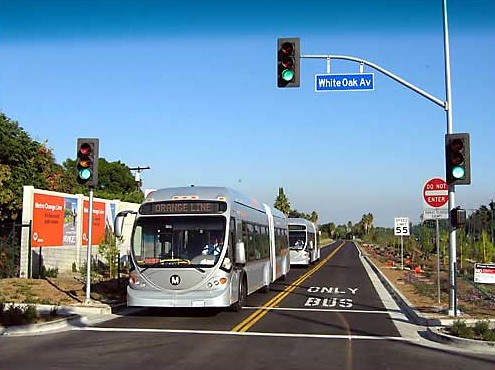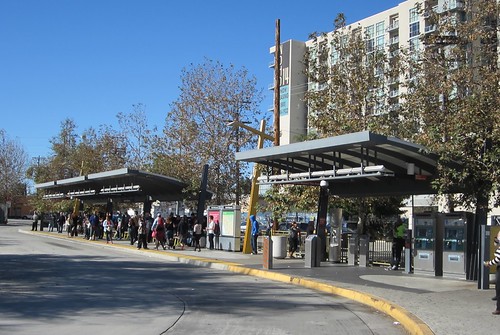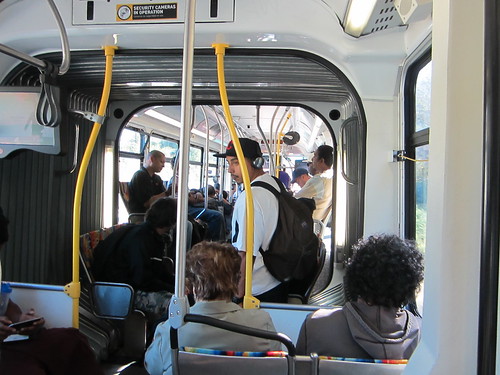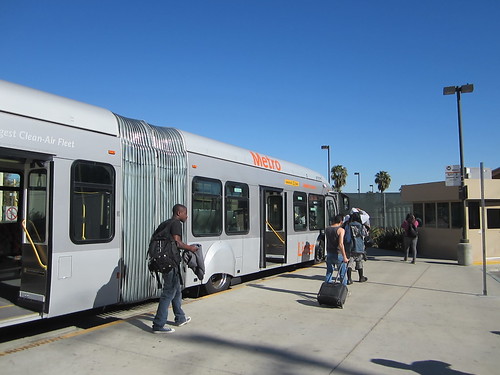When I visited Los Angeles earlier this winter, I took a ride on the Orange Line, a bus rapid transit route that offers a preview of what fast, reliable bus service will be like for transit riders on Ashland Avenue.
The Orange Line launched in 2005 as a 14-mile route through the San Fernando Valley, with 14 stops spaced about a mile apart, built at a cost of $324 million, on a right-of-way formerly used by passenger rail and streetcars. In 2012, a four-mile extension and four more stops were added at a cost of $215 million. It’s eastern terminus is the North Hollywood transit center, where you can catch various other city bus lines, as well as the Metro Red Line subway to downtown LA, which I rode to a talk at City Hall by former Chicago transportation chief Gabe Klein.
The Orange Line has some significant differences from Chicago’s Ashland BRT plan. Because it’s completely separated from parallel car traffic, keeping cars out of the busway is not a major concern, whereas camera enforcement will needed for Ashland. The Orange Line does make multiple at-grade crossings of streets, controlled with stoplights. Signal prioritization helps keep the buses moving through these intersections.
The LA system includes prepaid boarding – you buy a ticket at a kiosk that you must display during occasional onboard inspections – which helps speed boarding. The buses are sleek 60-foot vehicles with low floors that make it easy to board, although there aren’t level boarding platforms like there will be on Ashland. The Orange Line buses are articulated vehicles with three doors on the right side, which further expedite boarding. Ashland will use the same 60-foot, articulated, five door buses as Cleveland’s Health line, which allow for boarding on the left side as well, which will be necessary for Ashland’s median stations.
The stations feature handsome shelters and signs. The route is nicely landscaped, and a high-quality bike and pedestrian path parallels it for most of its length. The buses have racks in front that can carry three bicycles in front, and there are bike parking racks and lockers at every stop.
Thanks to fewer stops and faster cruising speeds, the Orange Line buses have an average speed of just over 20 mph, including stops, faster than the 15.9 mph speeds projected for Ashland. As a result, a crosstown trip that used to take 81 minutes now only takes 44-52 minutes, which saves passengers an hour on the round trip.
This time saving makes the system quite popular. The Orange Line sees 30,000 boardings on an average weekday, according to LA County Metro Spokesman Paul Gonzales. That’s about what Ashland gets now, but on the LA system crowding has become an issue as it has become more popular. This has some people calling for the system to be converted to rail.
“Many people envisioned the Orange Line as a light rail line when it was first conceived,” Streetsblog LA editor Damien Newton told me. “Even though the bus line has exceeded ridership expectations, there is still a disappointment for many.” He noted that there has been no real development boom around the Orange Line stations.
“But I'm not sure I would call it a missed opportunity,” he added. “If nothing else, the Orange Line showed people how [BRT] buses could work, and made campaigns for simpler bus-only lanes throughout the city a much easier concept for people to support.”
I found riding the Orange Line to be a very pleasant bus experience. Boarding through the multiple doors having already paid my fare was much like getting on a subway car, and the large buses provided a relatively smooth ride with a fun sensation of speed – the traffic signals are timed for 35 mph cruising speeds. The buses were fairly full when I took them at non-peak times both during midday and early evening. Instead of ads, onboard TV screens showed public service announcements and trivia questions.
The Orange Line doesn’t provide an exact preview of the Ashland BRT, since it’s right-boarding and not integrated into an urban grid like the CTA service will be. But it does provide a sample of what service on nice, big buses, traveling at rapid transit speeds and unhindered by car traffic, will be like, features we can look forward to on Ashland.









